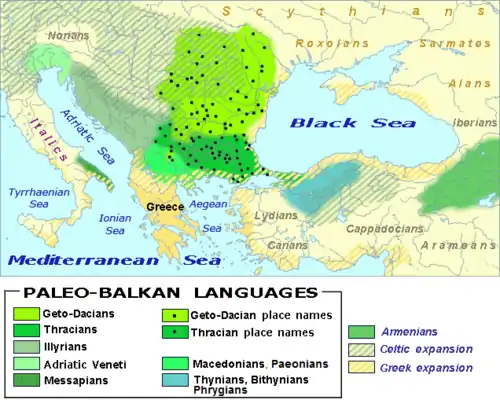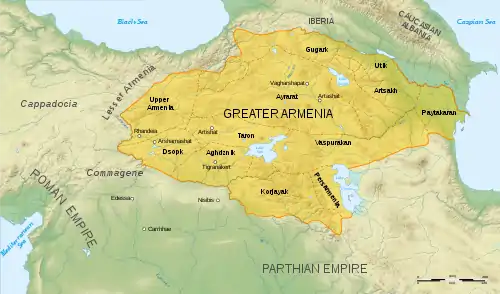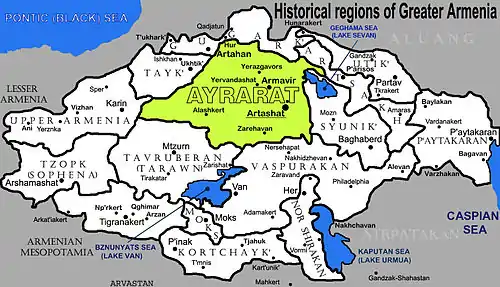List of ancient Armeno-Phrygian peoples and tribes
This is a list of the possible Armeno-Phrygian peoples and tribes. Armeno-Phrygians is the name given to the common ancestors of both Phrygians and Proto-Armenians and Ancient Armenians (ancestors of modern Armenians).
| Part of a series on |
| Indo-European topics |
|---|
 |
Ancestors
%252C_The_Horse%252C_The_Wheel_and_Language.jpg.webp)
Map 1: Indo-European migrations as described in The Horse, the Wheel, and Language by David W. Anthony
- Proto-Indo-Europeans (Proto-Indo-European speakers)
- Proto-Graeco-Phrygians (Proto-Graeco-Phrygian speakers)
- Proto-Graeco-Armenians (Proto-Graeco-Armenian speakers)
- Proto-Graeco-Phrygians (Proto-Graeco-Phrygian speakers)
Possible Direct Ancestors

Map 2: Paleo-Balkan peoples and their languages between the 5th and 1st century BC.
- Graeco-Phrygians
- Hellenics
- (?) Ancient Macedonians
- Proto-Greeks
- Ancient Greeks (esp. speakers of northern dialects)
- (?) Paeonians / Paeones There are different views and still no agreement among scholars about the Paeonians' ethnic and linguistic kinship. Some such as Wilhelm Tomaschek and Paul Kretschmer claim that the language spoken by the Paeonians belonged to the Illyrian family, while Dimitar Dechev claims affinities with Thracian. Irwin L. Merker considers that the language spoken by the Paeonians was closely related to Greek (and ancient Macedonian if it was a distinct language from ancient Greek), a Hellenic language with "a great deal of Illyrian and Thracian influence as a result of this proximity".[1]
- Agrianes[2] (also, Agriani and Agrii) (it is also claimed that this tribe was Thracian)
- Almopians[3] (also Almopioi)
- Derrones[4] (also Derroni) (it is also claimed that this tribe was Thracian)
- Doberes[5]
- Laeaeans[2] (also Laeaei and Laiai)
- Odomantes[6] (also Odomanti) (it is also claimed that this tribe was Thracian)[7]
- Paeoplae[8]
- Siropaiones[9]
- (?) Phrygians (Armeno-Phrygians? Part of the larger and older Graeco-Phrygians?)
- Hellenics
Armeno-Phrygians

Map 3: Historical Armenia, 150 BC

May have been part of the older and larger Graeco-Phrygians.
- Armeno-Phrygians (Bryges-Phryges-Mushki) (Armeno-Phrygian speakers)
- Bryges (Bryges, Mygdones and Pieres) (Haemus Mons or Balkan Phrygians)
- Bryges Proper
- Mygdones (in Mygdonia)
- Pieres (originally in Pieria, later in Pieris)
- Mushki (Mysians, Phrygians and Proto-Armenians) (Asia Minor Phrygians) (they may have entered Asia Minor in the Bronze Age collapse and also migrated eastward to Eastern Anatolia (Eastern Asia Minor); Eastern Mushki may have been identical with Eastern Phrygians and they possibly blended with older local populations and formed Proto-Armenians)[10][11][12] Other scholars, such as Aram Kossian have a different view and consider a native origin for the Eastern Mushki.[13]
- Western Mushki (Mysians and Phrygians)
- Mysians (Mushki) (Coastal Phrygians) (they lived in Mysia)
- Phrygians (Inland Phrygians) (they lived in Phrygia)
- Eastern Mushki (Moschoi / Moscheni / Meshech) (Proto-Armenians?)
- Meskhi (a Mushki tribe that lived in Moschia or Meskheti, assimilated by the Proto-Kartvelians?) (ancestors of most of the Meskhetians)
- Proto-Armenians (descendants of an eastward Phrygian migration - Mushki according to some scholars,[14] or from an early native origin, Eastern Mushki may have been a people of different origin from the Western Mushki, according to other scholars)[15]
- Ancient Armenians (Hayer)
- Ancient Armenian tribes
- Ancient Armenian Clans
- Ancient Armenian tribes
- Ancient Armenians (Hayer)
- Western Mushki (Mysians and Phrygians)
- Bryges (Bryges, Mygdones and Pieres) (Haemus Mons or Balkan Phrygians)
Possible Armenian peoples or contributors to the Armenians’ ethnogenesis
- Hayasa-Azzians (in Hayasa-Azzi, roughly in later Upper Armenia) (the name “Hayasa” may have been an early form of “Hayer” - Armenians)
- Nairi / Nihriya (a tribal confederation in the Armenian Highlands)
- Subartians / Shuprians / Armanians (in Subartu and Arme-Shupria, Arme or Armani and Shupria)
Armenians, Hurro-Urartians or Kartvelians
Contributors to the Armenians’ ethnogenesis (Non-Armenian in origin)
- Hurro-Urartians (peoples speakers of the Hurro-Urartian languages)
- Hurrians
- Hurri-Mitanni (a possibly Indo-Aryan Indo-European people was the founder or one of the founders of the Kingdom of Mitanni, they spoke the possible Mitanni-Aryan language, they blended with older local Hurrians)
- Urartians (founders of the Kingdom of Urartu; Proto-Armenians may have been part of the population of this kingdom since earlier times, well before its fall at the end of the 7th century BC.)[16][17][18]
See also
References
- "The Ancient Kingdom of Paionia". Balkan Studies 6. 1965.
- Early symbolic systems for communication in Southeast Europe, Part 2 by Lolita Nikolova, ISBN 1-84171-334-1, 2003, page 529, "eastern Paionians (Agrianians and Laeaeans)"
- The Landmark Thucydides: A Comprehensive Guide to the Peloponnesian War by Thucydides, Robert B. Strassler, Richard Crawley, and Victor Davis Hanson, 1998, ISBN 0-684-82790-5, page 153,"... of them still live round Physcasb- and the Almopians from Almopia.
- The Cambridge Ancient History, Martin Percival Charlesworth, ISBN 0-521-85073-8, ISBN 978-0-521-85073-5 Volume 4, Persia, Greece and the Western Mediterranean, C. 525 to 479 B.C, John Boardman, page 252, "The Paeonians were the earlier owners of some of these mines, but after their defeat in the coastal sector they maintained their independence in the mainland and coined large denominations in the upper Strymon and the Upper Axius area in the names of the Laeaei and the Derrones"
- The Histories (Penguin Classics) by Herodotus, John M. Marincola, and Aubery de Selincourt, ISBN 0-14-044908-6, 2003, page 452, "... Then he passed through the country of the Doberes and Paeoplae (Paeonian tribes living north of Pangaeum), and continued in a ..."
- An Inventory of Archaic and Classical Poleis: An Investigation Conducted by The Copenhagen Polis Centre for the Danish National Research Foundation by Mogens Herman Hansen and Thomas Heine Nielsen, 2005, ISBN 0-19-814099-1, page 854, ... Various tribes have occupied this part of Thrace: Bisaltians (lower Strymon valley), Odomantes (the plain to the north of the Strymon) ...
- Thrace in the Graeco-Roman world, p. 112 but others claim that together with the Agrianes and Odomanti, at least the latter of which were with certainty Thracian, not Paeonian.
- The Histories (Penguin Classics) by Herodotus, John M. Marincola, and Aubery de Selincourt, ISBN 0-14-044908-6, 2003, page 315, ... "was that a number of Paeonian tribes – the Siriopaeones, Paeoplae, ..."
- The Histories (Penguin Classics) by Herodotus, John M. Marincola, and Aubery de Selincourt, ISBN 0-14-044908-6, 2003, page 315, "... was that a number of Paeonian tribes – the Siriopaeones, Paeoplae, ..."
- I. M. Diakonoff The Problem of the Mushki Archived August 25, 2011, at the Wayback Machine in The Prehistory of the Armenian People
- Hrach Martirosyan “Origins and historical development of the Armenian language” (p. 7-9) in Journal of Language Relationship, International Scientific Periodical, n.º10 (2013). Russian State University for the Humanities, Institute of Linguistics of the Russian Academy of Sciences.
- Martirosyan, Hrach (2014). "Origins and Historical Development of the Armenian Language" (PDF). Leiden University: 1–23. Retrieved 5 August 2019. Cite journal requires
|journal=(help) - Kossian, Aram V. (1997), The Mushki Problem Reconsidered, p. 262
- I. M. Diakonoff The Problem of the Mushki Archived August 25, 2011, at the Wayback Machine in The Prehistory of the Armenian People
- Kossian, Aram V. (1997), The Mushki Problem Reconsidered, p. 262
- I. M. Diakonoff The Problem of the Mushki Archived August 25, 2011, at the Wayback Machine in The Prehistory of the Armenian People
- Hrach Martirosyan “Origins and historical development of the Armenian language” (p. 7-9) in Journal of Language Relationship, International Scientific Periodical, n.º10 (2013). Russian State University for the Humanities, Institute of Linguistics of the Russian Academy of Sciences.
- Martirosyan, Hrach (2014). "Origins and Historical Development of the Armenian Language" (PDF). Leiden University: 1–23. Retrieved 5 August 2019. Cite journal requires
|journal=(help)
This article is issued from Wikipedia. The text is licensed under Creative Commons - Attribution - Sharealike. Additional terms may apply for the media files.